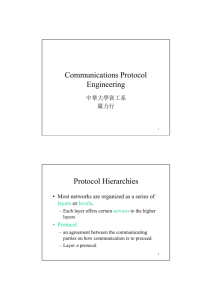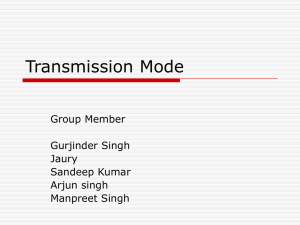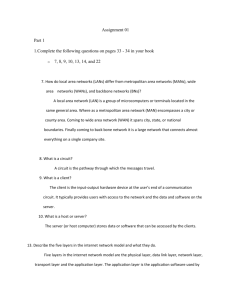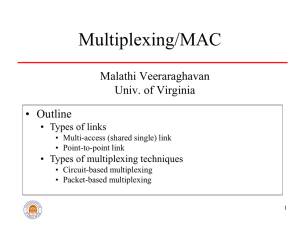Protocol Hierarchy
advertisement
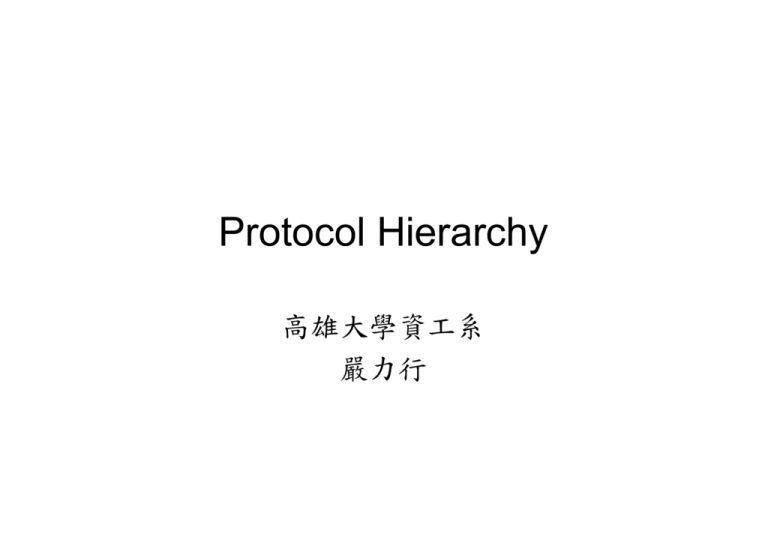
Protocol Hierarchy 高雄大學資工系 嚴力行 Protocol Hierarchies •Most networks are organized as a series of layers or levels. –Each layer offers certain services to the higher layers •Protocol –an agreement between the communicating parties on how communication is to proceed. –Layer n protocol Peers and Interfaces •Peers –The entities comprising the corresponding layers on different machines •Interface –between each pair of adjacent layers –defines which primitive operations and services the lower layer offers to the upper one. Entities and Peer Entities •An entity –an active element in a layer –can be a software entity (a process), a hardware entity (an I/O chip), or both (an I/O chip with its driver). •Peer entities –entities in the same layer on different machines Protocol Stacks •A protocol stack. –A list of protocols used by a certain system, one protocol per layer •Network architecture –A set of layers and protocols Protocol Hierarchy -- Example •Protocol – 中西式信封格式, 投遞方式, 寄 件 人 收 件 人 寄 件 人 收 件 人 4 郵 件 服務人員 郵 件 服務人員 3 分封打包 服務人員 分封打包 服務人員 2 運 輸 服務人員 1 運 輸 服務人員 Layer etc. •Peers – 寄件人, 收件人 – 郵筒收件人員(窗台收件人員), 郵差(窗台服務人員) •Layer 3/4 Interface –Services ‧平信, 掛號信, 雙掛號信 –Primitives ‧郵筒投遞, 郵局窗台掛號 Layers at An Interface SAP = Service Access Point ID U = Int erface D ata Unit SD U = Service D at a U nit PD U = Protocol D ata Unit ICI = Int erface Cont rol Informat ion ID U Layer N + 1 ICI SD U SAP Int erface Layer N ICI SD U SD U N -PD U Header Layer N ent it ies exchange N -PD Us in t heir layer N prot ocol Example: SAPs in LLC Higher Layer Higher Layer LLC LLC SAP MAC MAC PHY PHY Medium L2 Connections Multiplexing Upward Multiplexing: Several layer N connections should be multiplexed into a layer N-1 connection. Downward Multiplexing: a layer N connection uses several layer N-1 connections. Connections Multiplexing Application Application Application Application SAP Upward Multiplexing One-to-one Downward Multiplexing Layer N Layer N-1 Connection-Oriented and Connectionless Services •connection-oriented –Establish a connection first, use the connection, and then release the connection. –Example: the telephone system •connectionless –No connection is established. –Example: the postal system Service Primitives • Request – layer n+1 to layer n • Indication – layer n to layer n+1 – signal an event • Response Layer N+1 Layer N+1 1 3 4 Layer N 2 Layer N – layer n+1 to layer n – respond to the previous indication • Confirm – layer n to layer n+1 – confirm the previous request 1. CONNECT.request 2. CONNECT.indication 3. CONNECT.response 4. CONNECT.confirm Reference Models •The OSI Reference Model –based on a proposal developed by the International Standards Organization (ISO) –a first step toward international standardization of the protocols used in the various layers. •The TCP/IP Reference Model The OSI Reference Model 7 Application 6 Presentation 5 Session 4 Transport Application Protocol Presentation Protocol Session Protocol Transport Protocol Application APDU Presentation PPDU Session SPDU Transport TPDU Network Packet Frame 3 Network Internal Subnet Protocol Network Network 2 Data Link Data Link Data Link Data Link 1 Physical Physical Physical Physical Layer Host A Router Router Host B Bit Encapsulation/Decapsulation Mechanisms 往下送時訊框包裝 往上送時訊框拆裝 應用軟體 X 應用層 AH 表達層 TH 網路層 鏈結層 實體層 NH F A C Data 應用層 表達層 會議層 Data SH 傳輸層 應用軟體 Y Data PH 會議層 Data 傳輸層 Data 網路層 Data Data Bitstream 通訊路徑 FCS F 鏈結層 實體層 The TCP/IP Reference Model 7 6 5 4 3 2 1 Application Application Presentation Not present in the model Session Transport Transport Network Internet Data Link Physical Host-tonetwork OSI TCP/IP


